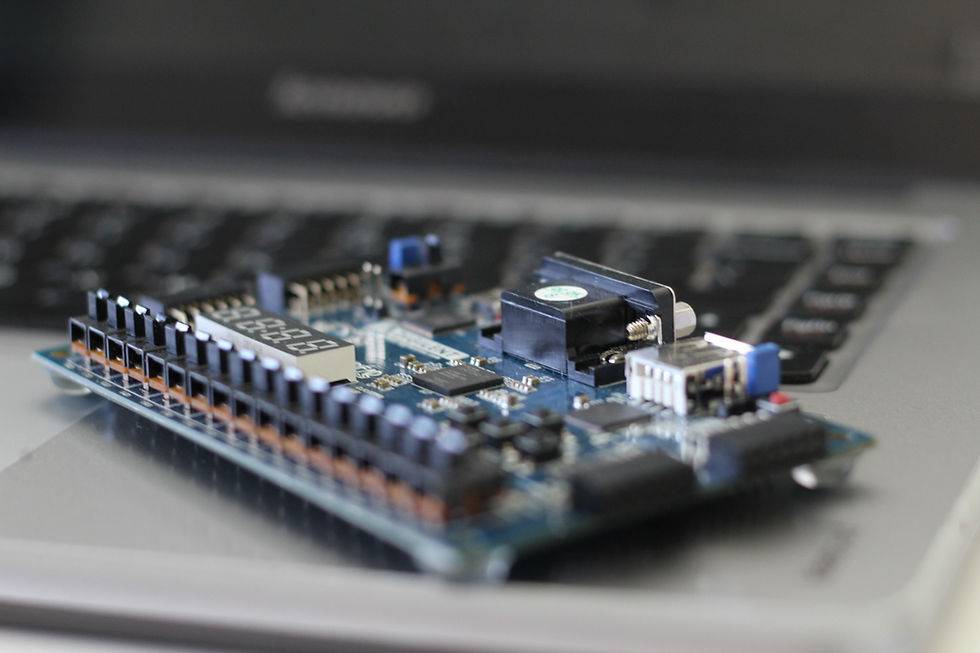Grundläggande språk för VHDL
VHDL Language Basics
– FPGA Programming and Simulation with VHDL
The VHDL Language Basics course is designed to provide professionals with a comprehensive understanding of the VHDL hardware description language. The course covers basic concepts of VHDL, VHDL syntax, combinational logic in VHDL, synchronous logic in VHDL, synthesis and testbenches, and hierarchical conception.
These topics are essential for the development of digital circuits and systems using VHDL, and are applicable to a wide range of applications, including the design of FPGA-based systems. The course is suitable for professionals with a basic understanding of digital design concepts, and is designed to provide a strong foundation in VHDL language development.
Objectives
Comprehend the various possibilities offered by VHDL language
Discover the complete design flow
Understand the logical synthesis notions
Implementing combinational and sequential logic
Developing Finite State Machines
Learning how to write efficient test benches for simulation
Checking Timings
Reusing and configuring components
Prerequisites
Knowledge of digital technology
Concepts of Boolean algebra
Some programming concepts are desirable (whatever language)
Target Audience
Any embedded systems engineer or technician with the above prerequisites.
Course Environment
Theoretical course
PDF course material (in English).
Course dispensed using the Teams video-conferencing system.
The trainer answers trainees' questions during the training and provide technical and pedagogical assistance through the Teams video-conferencing system.
Practical activities
Practical activities represent from 40% to 50% of course duration.
Code examples, exercises and solutions
One Online Linux PC per trainee for the practical activities.
The trainer has access to trainees' Online PCs for technical and pedagogical assistance.
Eclipse environment and GCC compiler.
QEMU Emulated board or physical board connected to the online PC (depending on the course).
Some Labs may be completed between sessions and are checked by the trainer on the next session.
Downloadable preconfigured virtual machine for post-course practical activities
At the start of each session the trainer will interact with the trainees to ensure the course fits their expectations and correct if needed.
Day One
From the logic gate to the FPGAs
Reminder on digital electronic
Combinational Logic
Sequential (Synchronous) Logic
Schematics / Hierarchical representation
Structure of an Integrated Circuit
SSI (small scale integration), TTL
MSI (medium scale integration), PALs, GALs, PLDs
LSI (large scale integration), CPLDs
VLSI (very large scale integration), ASICs, ASSPs, FPGAs
Development of logical architectures
Technology constraints
Interconnection methods (SRAM, Fuse, AntiFuse, Flash)
Clock distribution
Logic element types
Look Up Table
Basic logic cell
I/O modules
Timing issues
VHDL Contributions
Benefits of VHDL programming
The VHDL Design Flow
Programming
Simulation
Synthesis
Mapping
Place and Route
Timing Analysis
Bitstream generation
VHDL Basic concepts
The Entity / architecture concept
Entity declaration
Ports
Different styles of architecture
Libraries and context
Component instantiation
Port map
Simulation flow and environment
The Testbench
Getting started with the IDE
Creating a project from scratch
Synthesis / Translate / Map / Place and Route (PAR) /BitGen
Report Analysis
Assigning I/O locations using Planahead (editing constraint file)
Schematics Views
Analyzing the placement
Flashing with Impact
Exercise: | Understanding the steps of design and programming |
Exercise: | Getting started with the simulator, waveform generation and analysis |
Day Two
VHDL Syntax
Lexical items
Comments
Identifiers and keywords
Characters, Strings, Numbers, Bit strings
Constants
Signals
Variables and aliases
Data types
Scalar types:
Integer
Real
Enumerated type
Physical types
Composite types:
Array
Record
Special types
Library and Packages
Standard package
IEEE packages
Std_logic_1164 package
Multi-valued types
Multi-driver and resolved types
Numeric types
Type conversion
Aggregates
Attributes
Type attributes
Signal attributes
Exercise: | Getting started with the simulator, waveform generation and analysis |
Day Three
Combinational logic in VHDL (1st part)
Concurrent instructions
Component instantiation
Signal affectation
Simple affectation
With / Select / When statement
When / Else statement
Unaffected keyword
Variable aggregates
Relational operators
Arithmetic operators
Concatenation / Slicing
Combinational logic in VHDL – 2nd part
Sequential instructions
Processes
Sensitivity list, Wait statement
Potential interpretation incoherencies between logical synthesis and simulation
Signal affectation
Transparent Latch
Use of variables
If… Then… Else statement
Case… When statement
Null statement
Iterative statements:
For loop
While loop
Conditional Iteration
Numeric_std / Numeric_bit packages
Defined Types and Operators
Conversion functions
Ambiguity about the types and the « use » clause
Exercise: | Coding, simulating and synthesizing a bounds enforcer |
Exercise: | Designing a 7-segment decoder |
Exercise: | Designing a 4-bit adder |
Synchronous logic in VHDL
Limits of asynchronous designs
Synchronous Design, Registers and Timing
Pipeline notion
D Flip-flop description
Use of Variable for synchronous process
Variable Synthesis
Reset and Set management
Clock Enable
Tri-state buffers description
Synchronous design methodology
Memory Synthesis
Asynchronous RAM
Synchronous RAM
Single port
Double port
Pipelined
ROM
IP generator introduction
Exercise: | Designing a counter/decounter |
Exercise: | Designing a FIFO |
Day Four
Synthesis and Testbenches
Synthesis
Syntactic and Semantic Restriction
Creating synthesizable Designs
Inferring Hardware elements
Initialization and Reset
Pragmas
Testbenches
A few basic rules for the writing of an efficient test bench
Potential incoherencies between logical synthesis and simulation: how to avoid it
VHDL instructions specific to simulation
Testbench with File I/O
Exercise: | Designing and testing a logical address decoder |
Exercise: | Simulation of sequential processes |
Exercise: | Advanced simulation techniques Text files |
Hierarchical Conception
Hierarchical division
Analysis and Elaboration
Components and Configurations
Components
Configuring components instances
Direct instantiation
Basic configurations
Configuration declaration
Default binding
Configuration specification
Port map and Generic map
Genericity and automatic configuration of re-usable modules
Packages
Package Declarations
Package Bodies
Using package
Libraries
Exercise: | Designing a generic 4-digits BCD-counter and displaying it on a 7-segment display |
Exercise: | Enhancing a 4-bit BCD-counter/decounter to create a generic one |
Exercise: | Working with configurations |
Exercise: | Designing a n digits BCD-counter/decounter and displaying it on a 7-segment display |
Nohau Training Partner
This course is provided by a Nohau Training Partner, a trusted provider of hands-on training for professionals in embedded systems, software development, and engineering.





